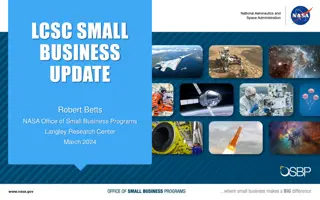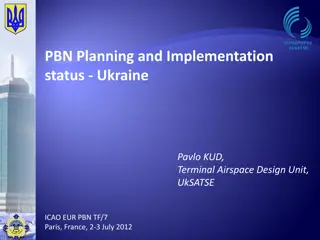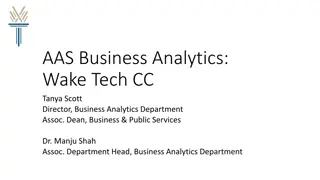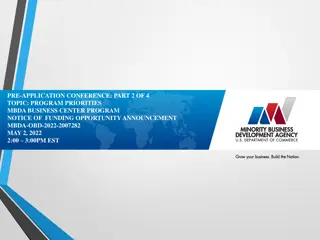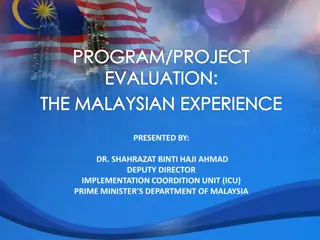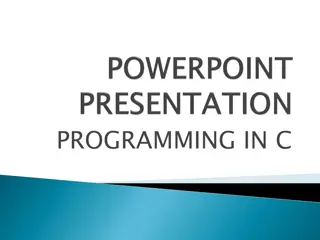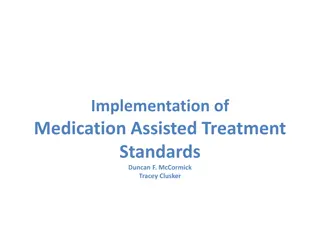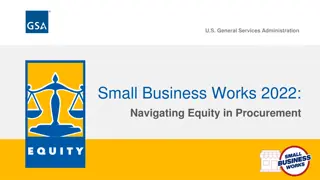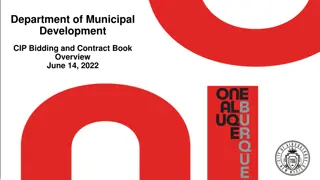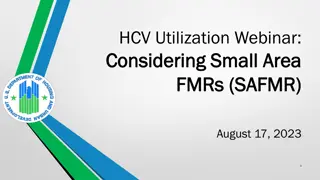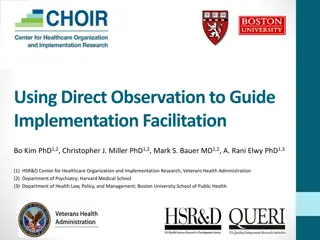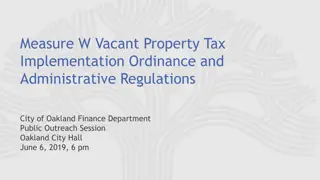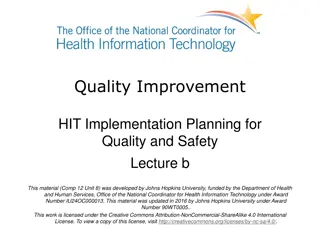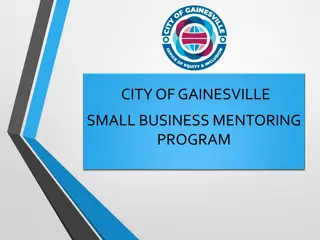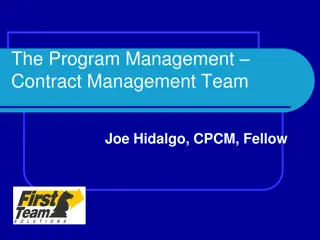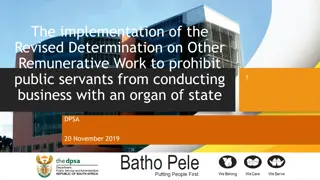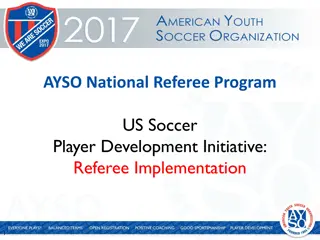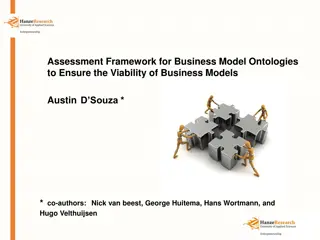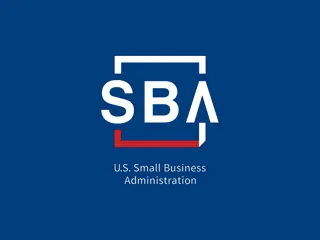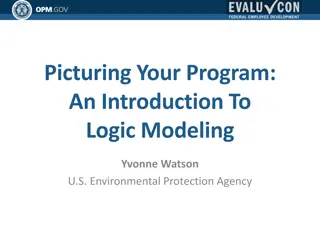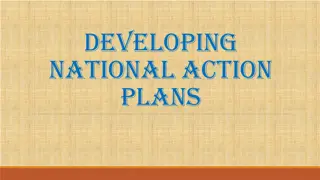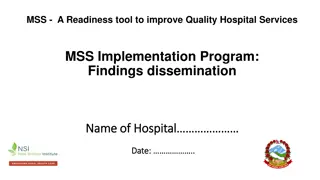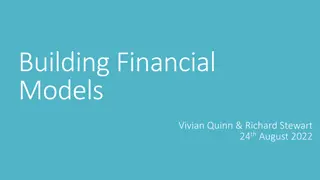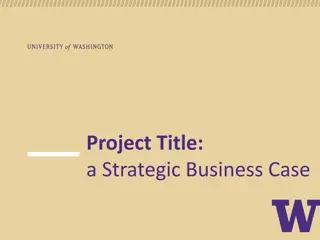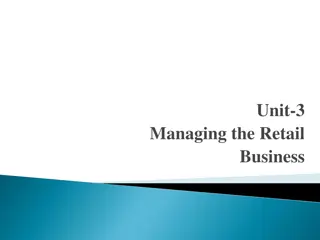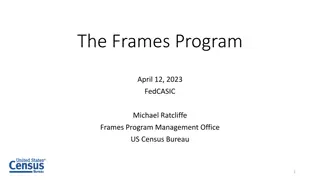Implementation of SDVOSB Business Development Program Presentation
At the SBA Advisory Committee on Veterans Business Affairs, Max V. Kidalov presents on legal authorities and alternatives for implementing the SDVOSB Business Development Program. The presentation covers research on the Cohen-Eimicke Contract Management Performance Model, administrative law obstacles, and recommendations for the program's success.
Download Presentation

Please find below an Image/Link to download the presentation.
The content on the website is provided AS IS for your information and personal use only. It may not be sold, licensed, or shared on other websites without obtaining consent from the author. Download presentation by click this link. If you encounter any issues during the download, it is possible that the publisher has removed the file from their server.
E N D
Presentation Transcript
Implementation of the Service-Disabled Veteran-Owned Small Business (SDVOSB) Business Development (BD) Program Presentation to the SBA Advisory Committee on Veterans Business Affairs by Max V. Kidalov, J.D., LL.M Assistant Professor Procurement Law & Policy Naval Postgraduate School Kidalov 1
Presentation Scope Research Problem: At the invitation of the AC/VBA Chairman, this presentation will address potential legal authorities and alternatives for implementation of the SDVOSB Business Development (BD) Program. While not restricted only to contracting, this Program is to reflect the Cohen-Eimicke Contract Management Performance Model (CMPM) and CMPM distinctions between inputs (resources), process (outcome-focused, outputs-centered program process), outputs (SDVOSB firms), and outcomes (business development, market openness, veteran self-employment). The usual credits and disclaimers: Statements herein do not constitute official views of NPS or the Departments of the Navy and Defense. The presentation is made in recognition of the AC/VBA powers and authorities under Public Law 106-50. The presenter would like to acknowledge the assistance of Jennifer Lee in the underlying research, An Open Door and a Leg Up: Increasing SDVOSB Participation in Defense, Navy, and Marine Corps Contracts through Simplified Acquisitions (2015). 2
Methodology I. Review of the current SDVOSB Program Design Taxonomy from Kidalov/Lee Report and related legislative/regulatory history. II. Identifying the administrative law obstacle of prior regulatory design to be solved by the SDVOSB BD Program. III. Review of administrative law literature and precedents addressing: - deference to agency reversals of prior statutory interpretations and regulations; - authority for Executive Orders on socio-economic contracting IV. Review of options for AC/VBA recommendations. V. Discussion, Questions, Comments, Updates 3
Review of Kidalov-Lee Report Research Questions: 1. Can the SDVOSB Program be understood in terms of the generally accepted contract management performance model (inputs, process, outputs, and outcome)? Yes. 2. Is individual-level Contracting Officer discretion the right mechanism to support SDVOSB participation in Defense contracting? No. It essentially leads the current SDVOSB Program to be focused on spending the greatest dollar amounts with the least number of SDVOSB firms. 3. Can Simplified Acquisitions positively influence Program outcomes? Yes, as part of agency-level or government-wide SDVOSB Business Development program. 4
Contract Management Performance Model Cohen & Eimicke, The Responsible Contract Manager (2008) Inputs Process Outputs Outcome Applied to the SDVOSB Program Inputs Process Outputs Outcome DOD Contracting as a Viable Self- Employment Path for Service-Disabled Veterans at Large Number of Active SDVOSBs receiving contract awards Individual-level DOD Contracting Officer discretion, laws, regulations, orders, precedents, plans Dollars awarded with SDVOSB, bench-marked to the 3% statutory goal 5
SDVOSB BD Program: Recommended Objectives 1. Program focus on inputs (contract spending or technical assistance resources) is useful, but not sufficient. Program must be outcome-focused and output-centered to redress veteran disillusionment. 2. Program process must transition from facilitating entrenchment by already-successful firms to facilitating broad- based participation. Process must help make SDVOSB contracting a viable path to self-employment and make Federal market genuinely open to SDVOSBs. 3. Program process must clear up veteran and buyer confusion over the nature of contracting-related assistance. Someone above the Contracting Officer level should decide what kind of business development need is worth a set-aside contract. 6
SDVOSB BD Program: Recommended Features 1. SDVOSB Business Development plans tailored to program outputs (participants), with outcome-based focus. The plans would contemplate holistic CCC assistance: Counseling/Training/Technical Assistance; Access to Capital; Contracting; possibly, Regulatory Relief. 2. Contracting Process designed to bring clarity and certainty to Contracting Officer discretion: a) SDVOSB sole source authority could be targeted to business development need and, perhaps, time-limited (graduation after several years unless health or personal care circumstances necessitated otherwise), with subsequent transitioning into permanent competitive set-asides/preferences, cascading, full and open competition, or commercial and international markets; b) Designation and Retention of contract requirements in the SDVOSB BD Program, ability to gain experience from MPT to Simplified Acquisitions (SAT/SAP) and above; c) Certification of SDVOSB firms; d) Match of SDVOSBs to Program requirements within buying agencies. 3. Periodic progress reviews of SDVOSB firms by the SBA. 7
SDVOSB Program Taxonomy Design(s) 4/3/2007 12/16/2003 Unutilized Business Development Direction - Veterans Benefit Act Pubic Law 108- 183 Section 101 and 102 COFC - Knowledge Connections v. US 3% Goals Legally Binding and KO must Consider new/niche SDVOSBs in Acquisition Strategy 11/1/2011 Task Force Report I: KOs to Utilize MAX PRAC, MACS, IDIQ's 10/20/2004 OFPP and SBA Make Agencies Responsible for SDVOSB Strategy Development; Set-asides Optional 12/6/2012 6/23/2007 1/1/1997 9/27/2010 GAO - Split Rock-Costs KO s Again Obligated to Set Aside for SDVOSB Next Edition of DOD 5 Year Strategic Plan Small Business Jobs Act 2010 Discretion to Set Asides on MAC and IDIQ and "Program Parity" "Fair Consideration" in purchase by Federal Gov & Business Development Assistance - Small Business Reauthorization Act of 1997 1/1/2008 6/5/2003 7/15/2014 GAO MCS and IBV Ltd - SDVOSB "MAY" Set Aside but MUST Consider Rejection of Access to 8(a) Program in HR 1460 Veterans Entrepreneurship and Benefits Improvement Act 3/23/2005 1/4/1999 Senate Hearing Identified Problem with KO Discretion and SAP Problems SBA Regs state SDVOSB NOT a Business Development Program Congressional Commission SDVOSB to Receive 8(a) Assistance and Goals 1/14/2009 Final Edition of DOD Strategic Plan of 2003 1997 2014 1997 1999 2001 2003 2005 2007 2009 2011 2013 DOD Achieves 3% Spending Goal to SDVOSB 10/23/2014 KO's to use Tool of Set Asides and Sole Sources for SDVOSB by Veterans Benefit Act of 2003 Public Law 108-183 Section DOD 5 Year SDVOSB Strategic Plan Far Council - FAR Part 19.2039(d) SHALL use Market Research to Determine SDVOSB Set Asides 2/4/2011 SDVOSB Given Socio- Economic 8/17/1999 GAO - DAV Prime, Inc. - Determinatio n of MCS and IBV Ltd. Reversed - KO's Not Required to Consider SDVOSB Set Asides 5/8/2008 Goals of 3% to SDVOSB Established by Public Law 106-50 5/31/2005 Small Business Status 1/4/1999 COFC/CAFC Kingdomware KO s may ignore Set Asides on FSS; should refuse set-asides to qualified SDVOSBs when 3% or higher Agency Goal is Already Met 1/1/2014 FAR Council Determines SDVOSB not a Business Development Program 308 12/16/2003 SDVOSB Need Identified 4/26/2010 Executive Order 13540 Interagency Task Force on Veterans' Small Business Development 3% Goal Missed Opportunity for Business Development Support 2/23/2005 Executive Order 13360 Providing Opportunities for SDVB to Increase Their Federal Contracting and Subcontracting 10/20/2004 COFC- Knowledge Connections v. US - No duty to attract niche/new SDVOSBs 12/19/2007 USD AT&L Memos: KO's to set aside SDVOSB on GWAC, MAC, IDIQ's 4/12/2007 11/29/2012 Red Flags in SDVOSB Program Task Force Report II: - Expressly Promotes Established Firms and More Support for Contracting Officers Direction to Contracting Officer 8
SDVOSB Program Taxonomy: Legislative Designs Favoring Outputs (Programmatic BD Intent) Anti-Discrimination Amendment, Public Law 93-237 (1974), 15 USC 633(4) - special consideration to veterans, survivors, dependents Small Business Reauthorization Act of 1997, Public Law 105-135 (1997), Sections 701 and 707 - foster enhances entrepreneurship through increasing opportunities , ensure . . . fair consideration in purchase, vigorously promote the legitimate interests of SDVOSBs; - such actions as may be necessary to ensure SDVOSBs have access to business development assistance and other programs established under the Small Business Act; - SBA to study percentage and dollar value of SDVOSB contract awards Congressional Commission on Service Members and Veterans Transition (Jan. 1999) - recommends admission of SDVOSBs to 8(a) program, plus statutory goal Veterans Entrepreneurship and Business Development Act of 1999, Public Law 106-50: - 3 percent goal; creation of business development entities within/out SBA - business development-related legislative history 9
SDVOSB Program Taxonomy: Legislative Design Favoring Inputs (Unguided KO BD & Spending Discretion) Veterans Benefits Act of 2003, Public Law 108-183 - created statutory authority for competitive and sole source set-asides - uncodified sections 101 and 102 explain business development assistance intent of the law: SEC. 101. FINDINGS. Congress finds the following: (1) Veterans of the United States Armed Forces have been and continue to be vital to the small business enterprises of the United States. (2) In serving the United States, veterans often faced great risks to preserve the American dream of freedom and prosperity. (3) The United States has done too little to assist veterans, particularly service-disabled veterans, in playing a greater role in the economy of the United States by forming and expanding small business enterprises. (4) Medical advances and new medical technologies have made it possible for service- disabled veterans to play a much more active role in the formation and expansion of small business enterprises in the United States. (5) The United States must provide additional assistance and support to veterans to better equip them to form and expand small business enterprises, thereby enabling them to realize the American dream that they fought to protect. 10
SDVOSB Program Taxonomy: Legislative Design Favoring Inputs (Unguided KO BD & Spending Discretion) Veterans Benefits Act of 2003, Public Law 108-183 - created statutory authority for competitive and sole source set-asides - uncodified sections 101 and 102 explain business development assistance intent of the law: SEC. 102. PURPOSE. The purpose of this Act is to expand existing and establish new assistance programs for veterans who own or operate small businesses. This Act accomplishes this purpose by (1) expanding the eligibility for certain small business assistance programs to include veterans; (2) directing certain departments and agencies of the United States to take actions that enhance small business assistance to veterans; and (3) establishing new institutions to provide small business assistance to veterans or to support the institutions that provide such assistance. 11
SDVOSB Program Taxonomy: Legislative Design Favoring Inputs (Unguided KO BD & Spending Discretion) Veterans Benefits Act of 2003, Public Law 108-183 - created statutory authority for competitive and sole source set-asides - legislative history, H.Rep. 108-142, explains non-8(a) business development assistance intent: The Committee notes the 1999 report of the bipartisan Congressional Commission on Servicemembers and Veterans Transition Assistance recommended that Special assistance, such as lending opportunities and access to a disadvantaged business development program like SBA's 8(a) program is needed to support disabled veteran entrepreneurs.'' H.R. 1460, as amended, does not make service-disabled veteran-owned small businesses part of the 8(a) program, but it does give them sole source/set-aside-type contracting opportunities on a discretionary basis. The Commission also concluded that, Disabled-veteran entrepreneurs require additional assistance because these business owners encounter costs and impediments that are not factors for their non-disabled competitors'' and ``As a matter of fundamental fairness, Congress should accord veterans a full opportunity to participate in the economic system that their service sustains. 12
SDVOSB Program Taxonomy: Contradictory Executive Branch Designs Favoring Outputs (BD), Inputs (Non-BD Spending) SBA Report of the Veterans Affairs Task Force on Entrepreneurship (1998) - recommends high priority to classify SDVOSBs as SDBs Executive Order 13360, Providing Opportunities for Services-Disabled Veteran Business to Increase Their Federal Contracting and Subcontracting (Oct. 20, 2004) - opportunities, 3 percent goal, participation, set-asides SBA and FAR Council Final Rules, March 23, 2005 (based on 2004 interim rules) - FAR Council: SDVSOB assistance not 8(a) business development; purpose of SAP to simplify procurement for SDVOSBs - SBA: SDVOSB Program a tool to meet goals, not business development SBA (Feb. 4, 2011) and FAR Council (March 2, 2012) amendments, post-SBJA: - parity, mandatory consideration of SDVOSB set-asides above SAT/SAP DOD Strategic Plans: 2005, 2007, 2009 (5-year): - set-asides process focus Executive Order 13540 Interagency Task Force on Veterans Small Business Development - 2011 Report to the President, Empowering Veterans Through Entrepreneurship and 2012 Report to the President, Heroes on the Home Front: Supporting Veteran Success as Small Business Owners focus on finding current SDVOSB contractors to meet 3 percent goal 13
Administrative Law Barrier to SDVOSB BD Program: The 2004-05 Regulatory Designs SBA Final Rule Comments, 70 Fed.Reg. 14523-14529 (March 23, 2005): SBA has reviewed this issue thoroughly and believes that the SDVO SBC Program, unlike the 8(a) BD Program, is not developmental in nature. Rather, it is the result of a recognized need to increase the participation of established SDVO SBCs in the Federal marketplace. The first attempt, Public Law 106 50, instituted the 3% goal for SDVO SBCs. When data indicated that the desired results were not being achieved, Public Law 108 183 was enacted. Public Law 108 183 established tools (a restricted competition and sole source authority) for Contracting Officers to use to reach that segment of the small business population. Although there is no prohibition against SBA establishing an SDVO SBC Mentor-Prot g Program, at this juncture, SBA prefers to wait and see if implementation of the procurement tools in Public Law 108 183 will allow contracting activities to reach their SDVO SBC goals. SBA notes that there is no prohibition for SDVO SBCs, when eligible, to participate in the Mentor-Prot g Programs of other agencies. [Note: No source for established quote was provided.] FAR Final Rule Comments, 70 Fed.Reg. 14950-14962 (March 23, 2005): It is important to note that the 8(a) Program is a business development program. While the 8(a) Program offers a broad scope of assistance to socially and economically disadvantaged small businesses, the SDVOSB Program strictly pertains to benefits in Federal Contracting. 14
SDVOSB BD Program Possible Sources of Authority 1. Presidential Constitutional powers as Commander-in-Chief and Presidential management and supervision powers over SBA, DOD, VA, and other agencies under the Constitution, the Small Business Act, Title 10, Title 38, and similar authorities. Analyzed under Youngstown (Steel Seizure Case) (1952). Constitutional powers used, e.g., in EO 12073, Federal Procurement in Labor Surplus Areas (also, supervision over SBA/GSA/DOL/OFPP). 2. Federal Procurement and AdministrativeServices Act (FPASA) 205, 40 U.S.C. 486 The President may prescribe such policies and directives, not inconsistent with the provisions of this Act, as he shall deem necessary to effectuate the provisions of said Act, which policies and directives shall govern the Administrator and executive agencies in carrying out their respective functions hereunder. Used by Presidents to create socio-economic contracting program, e.g. EO 12432, Minority Business Enterprise Development. Upheld in procurement DOL cases by the U.S. Supreme Court in Chrysler v. Brown (1979) and AFL v. Kahn (D.C. Cir. 1979). Specific FPASA mandate for regulations not required, only nexus to FPASA long-term economy and efficiency objectives. Small business participation and set-aside are recognized in FPASA 302 and 303, 41 U.S.C. 252 and 253 (Competition in Contracting Act). 3. Agency power to reconsider its prior policy. Agency policies can be made through so- called legislative formal rulemaking (notice and comment), interpretive rules, or polices. Analyzed under Chevron or Skidmore, depending on whether it is formal rulemaking or not. Under Brand X (2005), deference may be due to agency regulations overruling prior court decisions. Under Fox Television (2009), agencies may change their policies, but they have to give a reasoned explanation if based on new facts or if impact on prior reliance. 15
SDVOSB BD Program Pathways to Creation Kidalov-Lee (2015) research offers: (1) an alternative view of the 1974-2003 SDVOSB statutory authorities to authorize broad-based SDVOSB business development (BD), and (2) data/facts demonstrating that the 2004-2005 designs have not carried out that BD authority in practice (impact on long-term sustainability of 3% goal). Possible pathways to SDVOSB Business Development Program: I. Executive Order (with subsequent SBA/FAR Council Regulation Amendments) II. Stand-alone SBA/FAR Council Regulation Amendments, with or without 3 U.S.C. 301 delegation of Presidential powers to the SBA Administrator III. Agency-specific policies and EO 13360 Strategic Plans (including SAP NAICS/PSC targeting, BPAs, public interest, unilateral or joint SBA-agency set- asides per 15 U.S.C. 644(a), etc.). IV. Operational merger of the SDVOSB BD Program into the 8(a) SDB BD Program V. Executive Branch s legislative proposal to Congress proposing/requesting creation of the SDVOSB BD Program 16
I. SDVOSB BD Program: Executive Order Pathway 1. What are the advantages of the Executive Order pathway? It is the most comprehensive way to reverse an unduly restrictive prior interpretation of the 1997, 1999, and 2003 SDVOSB legislation in the 2004- 2005 SBA and FAR Council rulemaking. Advantages include: Coverage of agencies government-wide; therefore, coverage of all BD aspects (counseling, capital, contracting, regulatory relief, etc.); Use of Constitutional powers and statutory powers under multiple laws (including, but not limited to, the 1974 and the 1997-2003 legislation and EO 13360), thereby strengthening SBA role; Ability to direct interagency cooperation and to share/utilize/direct the use of resources of SBA as well as other agencies; President has the opportunity to shape program details and put them forward to Congress for acquiescence or amendment via budget process 2. What are the disadvantages of the Executive Order pathway? Possible criticisms/legal challenges to Presidential decision-making. 3. Should the Executive Order pathway be pursued? YES. Sufficient timing remains for OMB, interagency, and DOJ reviews. 17
II. SDVOSB BD Program SBA/FAR Regulations Pathway 1. What are the advantages of the SBA Regulations/FAR pathway? This pathway does not require additional DOJ review of Presidential authority that would apply to Executive Orders. This reversal pathway is also stronger than reversal by mere agency policies/Strategic Plans or interpretive rules. It will involve notice-and-comment rulemaking. It will rely on re-evaluation of both the 1974-2003 statutes and the facts about the current SDVOSB Program. This pathway would aim for courts to give SBA the so-called Chevron/Brand X/Fox Television deference. 2. What are the disadvantages of the Regulations pathway? It would lack Presidential mandate and attention, yet involve notice and comment rulemaking on an issue of major public policy importance. More importantly, courts could give this pathway much less deference than reversal came by Executive Order. The degree of deference to changing agency views of the statutes an agency administers is one of the most hotly contested areas of administrative law. Other SBA programs (e.g., HUBZone, 8(a)) faced challenges to SBA s authority to promulgate regulations creating them. Fox Television must be carefully followed. 3. Should the SBA (and FAR Council) proceed at least with Regulations? YES (over doing nothing or only doing agency policies/Strategic Plans). Moreover, even after the Executive Order there would be a need for regulatory amendments. However, Executive Order remains the more sound and effective pathway. 18
III. SDVOSB BD Program Agency Policies/Strategic Plans Pathway 1. What are the advantages of the pathway to create SDVOSB Business Development Programs via agency-specific policies/EO 13360 Strategic Plans? This is the quickest and the most flexible pathway. It can be tailored to the specific agencies contracts and other programs. It will not involve notice-and-comment rulemaking. It is within the SBA s advise and assist power in EO 13360. 2. What are the disadvantages of the policies/Strategic Plans pathway? Agency policies and plans could be judicially enforceable per Knowledge Connections I. However, even weak plans and policies may get wide deference under Knowledge Connections II. In practical terms, plans/policies may not be effective for/enforceable by the beneficiaries. These plans and policies would also get less deference than regulations or Executive Orders per Skidmore. In practical terms, opponents of SDVOSB contracting might have an easier time stopping these plans/policies without new regulatory or Executive Order backing. The degree of deference to changing agency views of the statutes an agency administers is one of the most hotly contested areas of administrative law. 3. Should the agencies, under SBA guidance, proceed to provide Business Development assistance to SDVOSBs under revised agency policies/Strategic Plans in furtherance of EO 13360 and the 1997-2003 legislation? YES. Doing so can stimulate best practices, but the impact will be limited. 19
IV. SDVOSB BD Program: 8(a) Program Operational Merger Pathway 1. What are the advantages of the pathway to create SDVOSB Business Development Programs via operational merger into the 8(a) Program? No separate program is really created. All 8(a) authorities would apply. 2. What are the disadvantages of the 8(a)-SDVOSB operational merger pathway? No separate program is really created. The Rothe (2008-09) (10 U.S.C. 2323 invalidation by W.D. Tex.) and Dynalantic (D.D.C. 2012) (8(a) invalid as applied in military simulator industry) cases illustrate the legal vulnerability of the 8(a) Program and any other programs tied to it. If tied to the 8(a) Program, the SDVOSB Program could be expected to stand or fall based on whether the 8(a) Program stands or falls. This means, among other things, strict scrutiny analysis versus rational basis analysis. In practical terms, disabled veterans fortunes would be hitched to the 8(a) litigation wagons. Continued SDVOSB assistance would depend on unrelated factors, e.g., evidence of continued race discrimination in a particular industry, and on scope of challenge to the 8(a) Program. 3. Should the SBA proceed at least with the 8(a)-SDVOSB operational merger? NO, and neither would it be prudent for any other agency attempt it. 20
V. SDVOSB BD Program: Legislative Creation Proposal to Congress 1. What are the advantages of the legislative creation proposal pathway? Broadest possible statutory support. 2. What are the disadvantages of the legislative creation proposal pathway? In light of very broad and plenary authorities in the 1974 and 1997-2003 legislation and the EO 13360, more authorizing legislation may appear unnecessary and redundant (avoidance of action). Further, there would be inevitable delays into 2017 or longer. Moreover, Congressional failure to act may encourage SDVOSB opponents to bring up challenges under the so- called non-delegation doctrine (however unlikely they are to succeed). 3. Should the SBA proceed with the legislative creation proposal to Congress? NOT AT THIS TIME; rather, the SDVOSB BD program should be included in the SBA s budget submissions to Congress. 21
Questions, Comments, Updates We need to look at this from the perspective of the soldier, not the perspective of the government. -Secretary of Defense Robert M. Gates on the wounded warrior transition system in Duty: Memoirs of a Secretary at War 22


